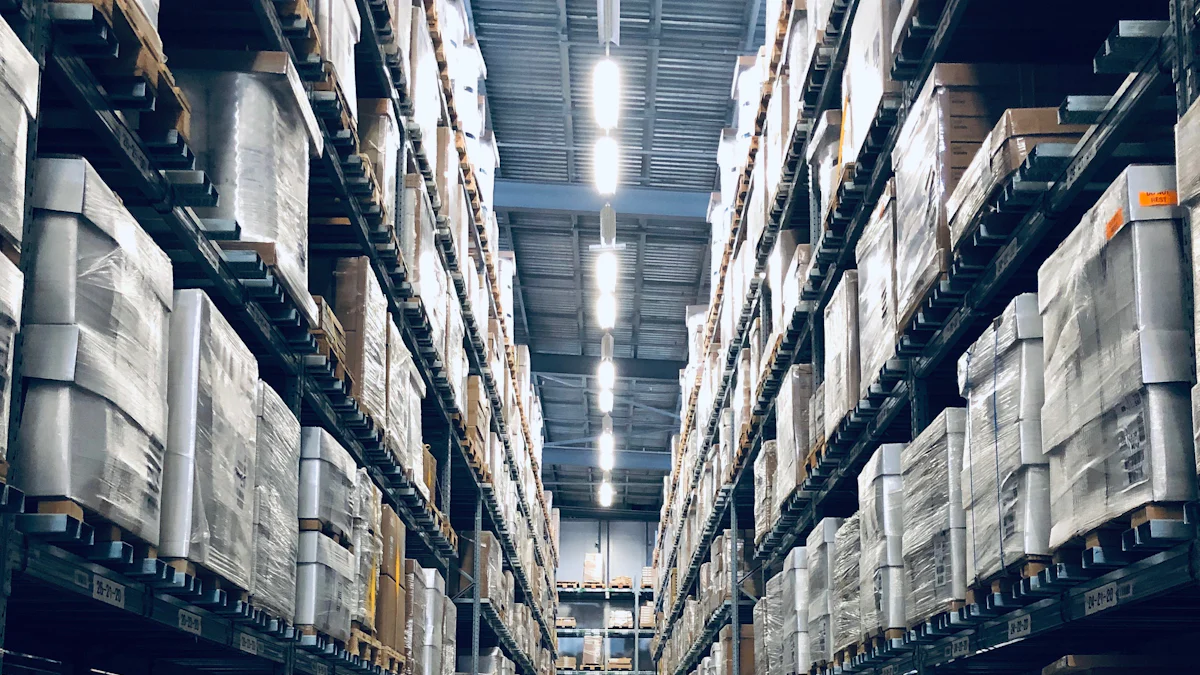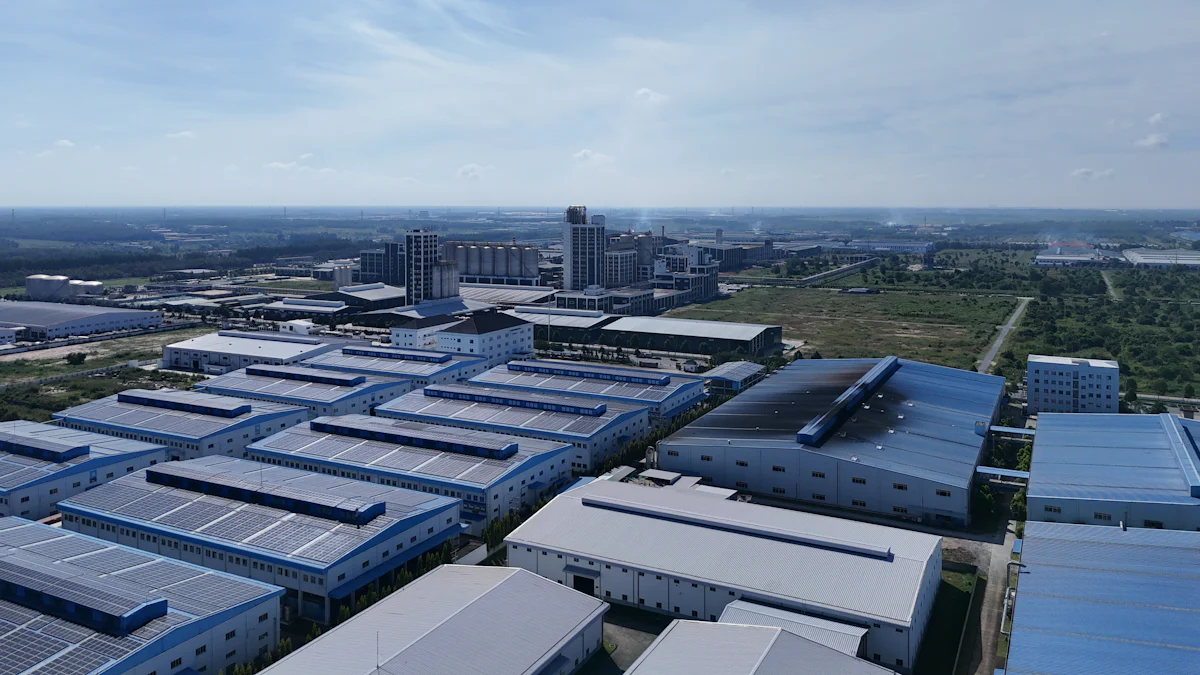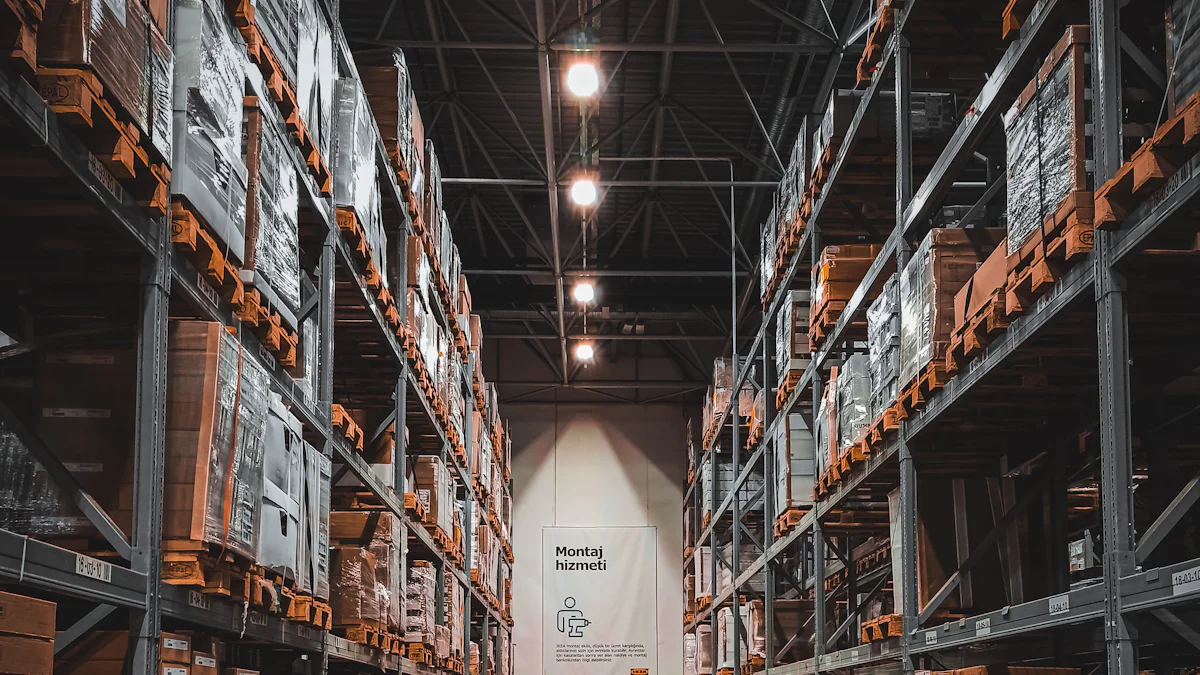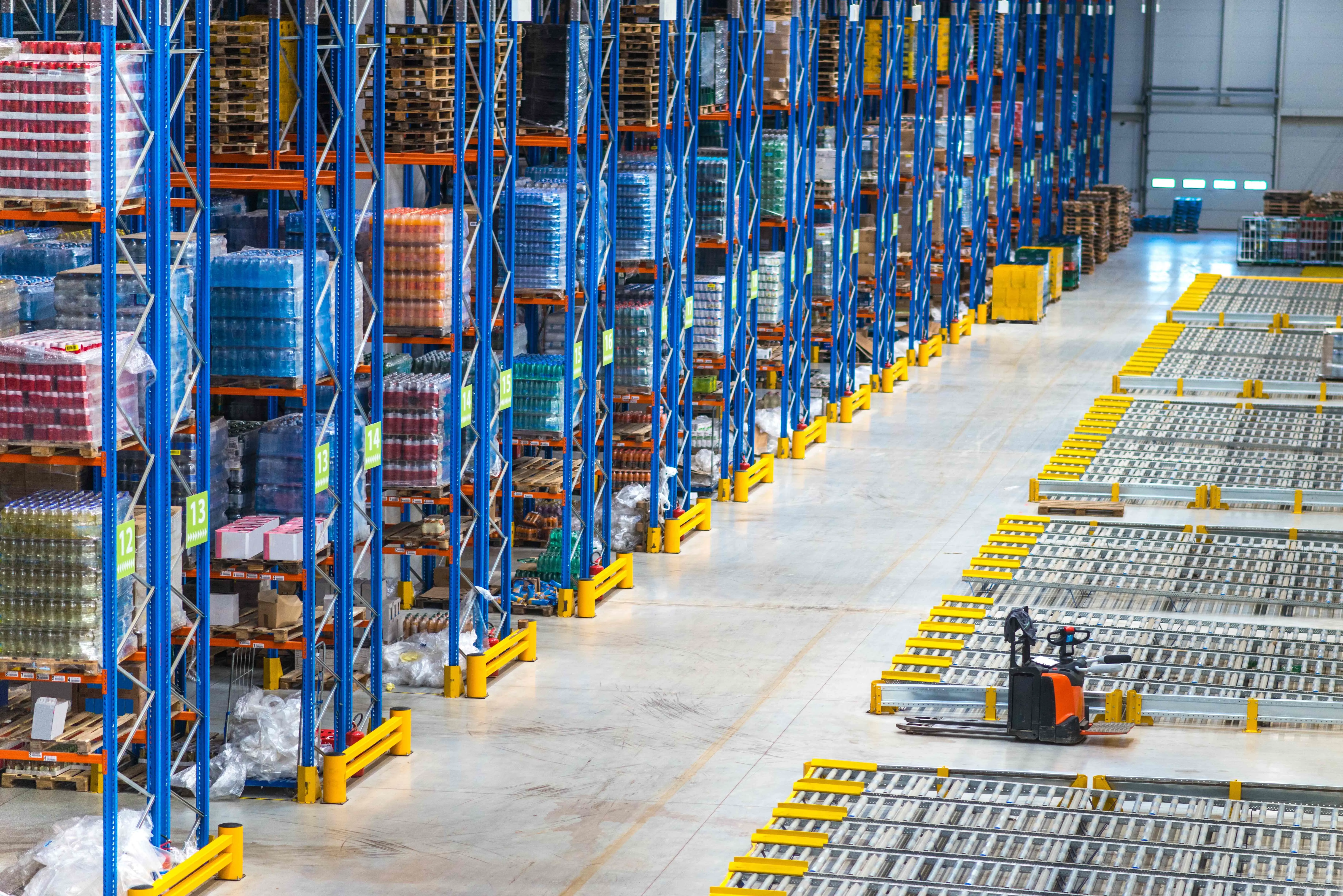How Urban Distribution Centers Improve Logistics Efficiency

Urban distribution centers are transforming how goods move through cities. These facilities bring products closer to consumers, cutting delivery times and improving efficiency. By optimizing delivery routes and consolidating shipments, they reduce transportation costs and congestion. Businesses benefit from faster deliveries, while cities see improved air quality due to fewer freight vehicle miles traveled. The rise of e-commerce has made these centers essential for meeting the demand for same-day delivery. Positioned strategically, they enhance customer satisfaction and streamline operations in the logistics industry.
Key Takeaways
Urban fulfillment centers significantly reduce delivery times by positioning products closer to consumers, enhancing customer satisfaction.
These centers optimize last-mile delivery costs through shorter routes and advanced technologies, leading to lower fuel consumption and operational expenses.
Sustainability is a key benefit, as urban fulfillment centers help reduce emissions and support eco-friendly practices, aligning with consumer demand for responsible businesses.
Strategically located in urban areas, these centers help businesses navigate challenges like traffic congestion and limited parking, ensuring efficient operations.
Leveraging technology such as route optimization and automation, urban fulfillment centers improve accuracy and speed in order processing.
Micro-hubs offer a cost-effective solution to high real estate costs, enabling faster deliveries without the need for large warehouses in city centers.
Collaboration with local delivery partners enhances flexibility and efficiency, allowing businesses to scale operations during peak demand periods.
Understanding Urban Fulfillment Centers in the Logistics Industry

What Are Urban Fulfillment Centers?
Urban fulfillment centers are specialized facilities designed to meet the growing demand for fast and efficient deliveries in cities. Unlike traditional warehouses, these centers focus on high activity and quick order processing rather than long-term storage. Their primary goal is to bring products closer to consumers, enabling faster delivery times and reducing logistical complexities.
You can think of urban fulfillment centers as hubs that bridge the gap between businesses and customers. They operate in densely populated areas, ensuring that goods are readily available for immediate distribution. This proximity to consumers allows companies to offer services like same-day or next-day delivery, which have become essential in today’s e-commerce-driven market.
"Urban fulfillment centers are not just storage spaces; they are dynamic hubs that prioritize speed and efficiency over bulk storage."
The Role of Urban Fulfillment Centers in Modern Supply Chains
Urban fulfillment centers play a pivotal role in modern supply chains by addressing the challenges of urban logistics. Traditional logistics models often struggle with issues like traffic congestion, parking restrictions, and the infamous "last-mile" delivery challenge. Urban fulfillment centers tackle these problems head-on by positioning inventory closer to end-users.
These centers also enhance supply chain flexibility. By reducing the distance between the product and the customer, they minimize transportation times and costs. This efficiency not only benefits businesses but also improves customer satisfaction. Faster deliveries mean happier customers, which translates to stronger brand loyalty.
Additionally, urban fulfillment centers contribute to sustainability. Shorter delivery routes reduce fuel consumption and emissions, making them an eco-friendly solution for urban logistics. As cities continue to grow, these centers will remain a cornerstone of sustainable supply chain strategies.
Strategic Importance of Urban Locations for Logistics Distribution Centers
The location of urban fulfillment centers is a critical factor in their success. Strategically placed in or near city centers, these facilities provide easy access to major roadways and established supply chains. This strategic positioning ensures that goods can move quickly and efficiently through urban areas.
Urban locations also allow businesses to overcome the unique challenges of city logistics. For example, traffic congestion and limited parking can delay deliveries. By operating closer to customers, urban fulfillment centers reduce the need for long-distance transportation, streamlining operations and cutting costs.
Moreover, these locations enable businesses to stay competitive in the fast-paced e-commerce landscape. With consumers expecting rapid delivery times, having a fulfillment center in an urban area gives companies a significant edge. It allows them to meet customer demands while maintaining operational efficiency.
Key Benefits of Urban Fulfillment Centers

Reduced Delivery Times and Enhanced Customer Satisfaction
Urban fulfillment centers excel at bringing products closer to consumers, which leads to significantly reduced delivery times. By positioning inventory in densely populated areas, these facilities ensure that goods are readily available for immediate distribution. This proximity allows businesses to offer same-day or next-day delivery services, meeting the high expectations of modern consumers.
Faster deliveries directly enhance customer satisfaction. When you receive your orders quickly and reliably, your trust in the retailer grows. This trust fosters loyalty, encouraging repeat purchases and positive word-of-mouth. Urban fulfillment centers also streamline order preparation and shipment processes, ensuring that your orders are accurate and delivered on time.
"Timely and reliable deliveries are the cornerstone of customer satisfaction in today’s fast-paced e-commerce environment."
The ability to deliver quickly not only benefits customers but also strengthens a business’s competitive edge. In a market where speed is a deciding factor, urban fulfillment centers provide a vital advantage.
Cost Optimization in Last-Mile Delivery
Last-mile delivery often represents the most expensive segment of the logistics process. Urban fulfillment centers help optimize these costs by reducing the distance between the product and the customer. Shorter delivery routes mean lower fuel consumption and fewer operational expenses.
Technology plays a crucial role in this cost optimization. Many distribution centers now use route optimization software and data analytics to plan the most efficient delivery paths. These tools save time and reduce unnecessary expenses, making operations more cost-effective. Additionally, urban fulfillment centers consolidate shipments, minimizing the number of trips required and further cutting costs.
Businesses also benefit from streamlined order preparation and shipment processes. By handling high-volume orders efficiently, urban fulfillment centers reduce labor costs and improve overall productivity. This efficiency translates into savings that can be passed on to customers, creating a win-win scenario.
Environmental Benefits Through Reduced Emissions
Urban fulfillment centers contribute to a greener logistics model by reducing the environmental impact of deliveries. Shorter delivery routes mean fewer vehicle miles traveled, which directly lowers fuel consumption and greenhouse gas emissions. This shift supports global efforts to combat climate change and promotes sustainable urban living.
Many distribution centers also invest in eco-friendly practices, such as using electric delivery vehicles or optimizing packaging to reduce waste. These initiatives align with the growing consumer demand for environmentally responsible businesses. When you choose a retailer that prioritizes sustainability, you’re supporting a cleaner and healthier planet.
"Urban fulfillment centers are not just about efficiency; they are a step toward a more sustainable future."
By integrating green logistics into their operations, urban fulfillment centers play a pivotal role in reducing the carbon footprint of the supply chain. This approach benefits both the environment and the communities they serve.
Competitive Advantages in the Evolving E-Commerce Landscape
Urban fulfillment centers give you a significant edge in the fast-paced world of e-commerce. These facilities enable businesses to meet the growing demand for rapid delivery services, such as same-day or next-day shipping. By positioning inventory closer to customers, they reduce delivery times and improve operational efficiency. This speed and reliability enhance your ability to attract and retain loyal customers.
The integration of technology in urban fulfillment centers further strengthens their competitive advantage. Tools like real-time route optimization and data analytics streamline delivery operations. These technologies help you save costs by improving fuel efficiency and reducing unnecessary trips. Additionally, micro-fulfillment centers and consolidation hubs allow for better shipment management, minimizing congestion and delays. This efficiency not only benefits your business but also improves the overall customer experience.
"Timely deliveries and efficient operations are the foundation of success in the e-commerce industry."
Urban fulfillment centers also create economic opportunities. They employ more people compared to traditional distribution centers, supporting local economies. Investments in robotics and automation enhance productivity while maintaining the critical role of human workers. This balance between technology and workforce ensures that your operations remain both efficient and adaptable.
Moreover, these centers offer a wide range of services tailored to specific business needs. From pick-and-pack fulfillment to handling high-volume replenishments, they provide flexibility to scale your operations. This adaptability is crucial in the evolving e-commerce landscape, where consumer expectations continue to rise.
By leveraging urban fulfillment centers, you position your business to thrive in a competitive market. Their ability to combine speed, efficiency, and adaptability ensures that you stay ahead of the curve while meeting the demands of modern consumers.
How Urban Fulfillment Centers Operate
Integration With Urban Logistics Networks
Urban fulfillment centers thrive by seamlessly integrating into urban logistics networks. These networks connect various components of the supply chain, ensuring that goods move efficiently from warehouses to customers. By positioning inventory closer to consumers, these centers reduce delivery distances and enhance last-mile customer fulfillment. This integration allows you to meet the growing demand for faster and more reliable deliveries.
Urban logistics networks rely on advanced planning and coordination. For example, route optimization tools help delivery drivers navigate congested city streets, ensuring timely deliveries. Additionally, these networks often include micro-hubs or smaller distribution points that further streamline operations. By leveraging these hubs, urban fulfillment centers can consolidate shipments and reduce the number of trips required, which contributes to the optimisation of costs.
"Well-organized urban logistics can reduce delivery times by shortening distances and utilizing efficient routes. This contributes to customer satisfaction, providing them with a smooth and timely shopping experience."
The success of these networks depends on collaboration among various stakeholders, including retailers, logistics providers, and local governments. By working together, they create a system that prioritizes efficiency and customer satisfaction. This collaborative approach ensures that urban fulfillment centers remain a vital part of modern supply chains.
The Role of Technology and Automation in JUSDA Warehouses
Technology and automation play a critical role in the operations of JUSDA warehouses. These innovations enable you to optimize times and costs while maintaining high levels of accuracy and efficiency. For instance, JUSDA employs advanced inventory management systems like JusLink, which provides real-time tracking and control over stock levels. This transparency ensures that you always know the status of your inventory.
Automation further enhances the efficiency of urban fulfillment centers. Robotic systems handle tasks such as picking, packing, and sorting, reducing the need for manual labor. These systems not only speed up operations but also minimize errors, ensuring that your orders are processed accurately. Additionally, JUSDA's use of AI-powered tools like JusAI improves decision-making by analyzing data and predicting demand patterns.
"Online retailers are increasingly building their own transportation networks and urban delivery facilities rather than contracting solely with shipping companies."
JUSDA's commitment to innovation extends to its use of eco-friendly technologies. Electric delivery vehicles and energy-efficient warehouse designs align with the company's goal of reducing its environmental impact. By integrating these technologies, JUSDA warehouses set a benchmark for sustainable and efficient urban logistics.
Collaboration With Local Delivery Partners for Seamless Operations
Collaboration with local delivery partners is essential for the smooth operation of urban fulfillment centers. These partnerships allow you to leverage the expertise and resources of local carriers, ensuring that deliveries are completed efficiently. Local delivery partners bring valuable knowledge of the area, helping to navigate challenges such as traffic congestion and parking restrictions.
This collaboration also enhances flexibility. By working with multiple partners, urban fulfillment centers can scale their operations to meet fluctuating demand. For example, during peak shopping seasons, additional delivery resources can be deployed to ensure timely order fulfillment. This adaptability is crucial for maintaining customer satisfaction in a dynamic urban environment.
"Customers in urban areas expect fast, reliable, and convenient delivery services. Fulfilling these expectations is crucial to ensure customer satisfaction and loyalty."
JUSDA emphasizes the importance of building strong relationships with its delivery partners. Regular communication and shared goals create a cohesive network that prioritizes efficiency and reliability. This approach not only benefits your business but also ensures a positive experience for your customers.
Challenges and Solutions for Urban Fulfillment Centers
Infrastructure Limitations in Urban Areas
Urban areas often face infrastructure challenges that can hinder the efficiency of fulfillment centers. Limited road capacity, traffic congestion, and restricted parking spaces create obstacles for delivery vehicles. These issues slow down operations and increase delivery times, impacting customer satisfaction.
To overcome these limitations, you can adopt advanced logistics technologies. Route optimization tools help delivery drivers navigate congested streets efficiently. Micro-hubs, strategically placed within cities, act as smaller distribution points to reduce delivery distances. These hubs streamline operations by consolidating shipments and minimizing the number of trips required.
"Well-planned urban logistics networks can mitigate infrastructure challenges, ensuring faster and more reliable deliveries."
Collaboration with local governments also plays a vital role. By working together, businesses and municipalities can develop solutions like dedicated delivery zones or off-peak delivery schedules. These initiatives improve traffic flow and enhance the overall efficiency of urban fulfillment centers.
Addressing Environmental Concerns With Green Logistics
The environmental impact of urban logistics is a growing concern. Delivery vehicles contribute to air pollution and greenhouse gas emissions, especially in densely populated areas. As a business, adopting green logistics practices can help address these challenges while aligning with consumer demand for sustainability.
Electric delivery vehicles offer a practical solution. These vehicles reduce emissions and operate quietly, making them ideal for urban environments. Many urban fulfillment centers are also investing in energy-efficient warehouse designs and renewable energy sources to minimize their carbon footprint.
"Green logistics is not just an option; it is a necessity for sustainable urban living."
Automation further supports sustainability efforts. Robotic systems in warehouses optimize operations, reducing energy consumption and waste. Predictive analytics improve inventory management, preventing overstock and minimizing unnecessary shipments. These technologies enhance efficiency while promoting eco-friendly practices.
By integrating green logistics into your operations, you contribute to a cleaner environment and build trust with environmentally conscious customers. This approach benefits both your business and the communities you serve.
High Real Estate Costs and Innovative Solutions Like Micro-Hubs
Urban real estate costs pose a significant challenge for fulfillment centers. High property prices and limited space make it difficult to establish large-scale facilities in city centers. However, innovative solutions like micro-hubs offer a way to address this issue.
Micro-hubs are smaller, strategically located facilities that support last-mile delivery. These hubs reduce the need for large warehouses in expensive urban areas. By positioning inventory closer to customers, micro-hubs enable faster deliveries and lower transportation costs.
"Micro-hubs represent a cost-effective solution to the challenges of urban real estate."
Automation also helps maximize the use of limited space. Advanced warehouse systems, such as those used by JUSDA, enhance storage efficiency through precise item placement and retrieval. Robotic systems handle repetitive tasks, allowing you to optimize every square foot of your facility.
Collaboration with property developers can further reduce costs. Shared spaces or multi-use facilities provide affordable options for urban fulfillment centers. These partnerships create opportunities to expand your operations without incurring excessive expenses.
By embracing innovative solutions, you can overcome the challenges of high real estate costs and maintain efficient urban logistics operations.
JUSDA’s Approach to Overcoming Urban Logistics Challenges
JUSDA tackles urban logistics challenges with innovative strategies and advanced technologies, ensuring you achieve efficiency and sustainability in your operations. By integrating automation, predictive analytics, and collaborative solutions, JUSDA sets a benchmark for overcoming the complexities of urban supply chains.
Leveraging Automation for Operational Excellence
JUSDA employs cutting-edge automation in its warehouses to enhance productivity and reduce costs. Robotic systems handle repetitive tasks like picking, packing, and sorting, allowing workers to focus on strategic roles that require human intelligence. This shift not only increases efficiency but also minimizes errors caused by fatigue.
"Automation elevates human capabilities rather than replacing them, enabling workers to engage in intellectual tasks." – Kelton Kosik, Head of Supply Chain at Ware2Go.
Automated systems in JUSDA warehouses ensure consistent performance without breaks, boosting operational efficiency. Machines follow precise instructions, reducing human error and improving accuracy. For example, automated item placement and retrieval systems prevent misplacements, ensuring your inventory is always organized and accessible.
Predictive Analytics for Smarter Inventory Management
JUSDA integrates predictive analytics into its operations to revolutionize inventory management. This technology enables accurate demand forecasting, helping you avoid overstock or stockouts. Real-time data processing provides immediate insights, allowing you to make quick decisions and respond to market changes effectively.
With predictive analytics, JUSDA ensures optimal inventory levels, reducing waste and improving customer satisfaction. Accurate forecasting also minimizes returns, building trust with your customers. By adopting these advanced tools, you can streamline your supply chain and maintain a competitive edge.
Collaborative Solutions for Seamless Urban Operations
JUSDA emphasizes collaboration with local delivery partners to navigate urban logistics challenges. These partnerships leverage local expertise, ensuring efficient navigation of traffic congestion and parking restrictions. By working with multiple partners, JUSDA scales operations to meet fluctuating demands, especially during peak seasons.
Micro-hubs play a vital role in JUSDA’s strategy. These smaller, strategically located facilities reduce delivery distances and optimize last-mile logistics. By consolidating shipments at these hubs, JUSDA minimizes the number of trips required, cutting costs and improving delivery times.
"Micro-hubs represent a cost-effective solution to the challenges of urban real estate."
Commitment to Sustainability
JUSDA integrates green logistics practices to address environmental concerns. The use of electric delivery vehicles and energy-efficient warehouse designs reduces emissions and supports sustainable urban living. Automation further enhances eco-friendly operations by optimizing energy consumption and minimizing waste.
By adopting these practices, JUSDA not only reduces its carbon footprint but also aligns with the growing consumer demand for environmentally responsible businesses. This commitment to sustainability benefits both your operations and the communities you serve.
The Future of Urban Logistics with JUSDA
JUSDA’s approach combines innovation, collaboration, and sustainability to overcome urban logistics challenges. By leveraging automation, predictive analytics, and micro-hubs, you can optimize your supply chain and meet the demands of modern consumers. With JUSDA as your partner, you gain the tools and strategies needed to thrive in the evolving logistics landscape.

JUSDA Solutions
To provide you with professional solutions and quotations.
Urban fulfillment centers have become essential in the logistics industry, transforming how goods move through cities. These facilities reduce delivery times, optimize costs, and enhance service quality and reliability. By addressing challenges like infrastructure limitations and high real estate costs, they ensure efficient city logistics. Innovative solutions, such as micro-hubs and green logistics practices, promote sustainability while meeting the growing demand for same-day delivery. As e-commerce expands, urban logistics will continue to evolve, making these centers a cornerstone of modern supply chain strategies. Their role in fostering service flexibility and sustainability ensures their lasting impact on the industry.
See Also
Harnessing Robotics To Boost Warehouse Efficiency
Transforming Logistics: JUSDA's Approach To Enhanced Efficiency
Discover JUSDA's Innovative Warehousing Solutions For Efficiency
Understanding Robotic Automation's Role In Warehouse Efficiency
